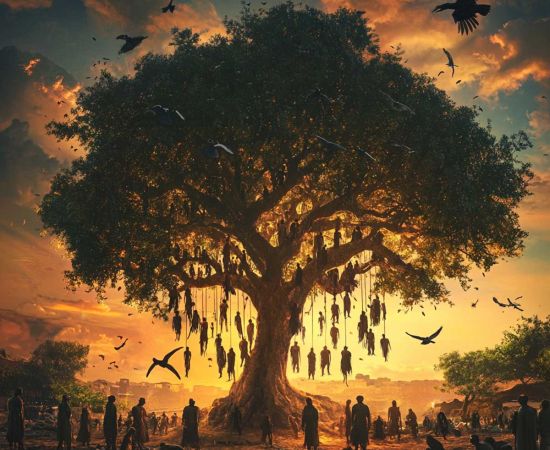MORE COVERAGE
Twitter Coverage
Satyaagrah
Written on
Satyaagrah
Written on
Satyaagrah
Written on
Satyaagrah
Written on
Satyaagrah
Written on
JOIN SATYAAGRAH SOCIAL MEDIA
“Let my heart be still a moment and this mystery explore”: Skeletons of Roopkund Lake of Chamoli, India - legend of Nanda Devi so enraged at outsiders who defiled her mountain sanctuary that she rained death upon them by flinging hailstones “hard as iron”

IN 1942 A BRITISH FOREST guard in Roopkund, India made an alarming discovery. Some 16,000 feet above sea level, at the bottom of a small valley, was a frozen lake absolutely full of skeletons. That summer, the ice melting revealed even more skeletal remains, floating in the water and lying haphazardly around the lake’s edges. Something horrible had happened here.
|
The immediate assumption (it being war time) was that these were the remains of Japanese soldiers who had died of exposure while sneaking through India. The British government, terrified of a Japanese land invasion, sent a team of investigators to determine if this was true. However upon examination they realized these bones were not from Japanese soldiers—they weren’t fresh enough.
It was evident that the bones were quite old indeed. Flesh, hair, and the bones themselves had been preserved by the dry, cold air, but no one could properly determine exactly when they were from. More than that, they had no idea what had killed over 200 people in this small valley. Many theories were put forth including an epidemic, landslide, and ritual suicide. For decades, no one was able to shed light on the mystery of Skeleton Lake.
However, a 2004 expedition to the site seems to have finally revealed the mystery of what caused those people’s deaths. The answer was stranger than anyone had guessed.
As it turns out, all the bodies date to around 850 AD. DNA evidence indicates that there were two distinct groups of people, one a family or tribe of closely related individuals, and a second smaller, shorter group of locals, likely hired as porters and guides. Rings, spears, leather shoes, and bamboo staves were found, leading experts to believe that the group was comprised of pilgrims heading through the valley with the help of the locals.
|
All the bodies had died in a similar way, from blows to the head. However, the short deep cracks in the skulls appeared to be the result not of weapons, but rather of something rounded. The bodies also only had wounds on their heads, and shoulders as if the blows had all come from directly above. What had killed them all, porter and pilgrim alike?
Among Himalayan women there is an ancient and traditional folk song. The lyrics describe a goddess so enraged at outsiders who defiled her mountain sanctuary that she rained death upon them by flinging hailstones “hard as iron.” After much research and consideration, the 2004 expedition came to the same conclusion. All 200 people died from a sudden and severe hailstorm.
Trapped in the valley with nowhere to hide or seek shelter, the “hard as iron” cricket ball-sized [about 23 centimeter/9 inches circumference] hailstones came by the thousands, resulting in the travelers’ bizarre sudden death. The remains lay in the lake for 1,200 years until their discovery.
Scientists have concluded that the skeletons discovered near the frozen lake belonged to pilgrims and locals who died due to hail storms. During the 2004 study of these skeletons, scientists collected bone samples and bits of preserved human tissue. They conducted DNA tests, which revealed an astonishing fact: the skeletons belonged to two distinct groups of people, as evidenced by differences in the bone features of their bodies. The skeletons were divided into two groups: family skeletons and shorter skeletons.
Were these two groups related? According to scientists, they were not. A few of these samples contain DNA that is found nowhere else in the world but only in a specific group of people from Maharashtra, while others contain DNA that has characteristics of Himalayan hill people. The researchers concluded that the deaths were caused by a fatal blow to the back of their heads, not by weapons, avalanches, or landslides. The marks on their skulls and shoulders indicated that they had been struck by something round, such as a cricket ball. The lack of injuries to other parts of the body suggested that hard round objects, possibly cricket ball-sized hailstones or ice balls had fallen from above and killed them.
According to a study published in 2019 by a team of Indian and international scientists, the remains belonged not only to Indians but also to people from Southeast Asia and faraway Greece. According to the scientists, they did not die in a single catastrophic event, but rather as a result of a series of incidents that occurred over a thousand years. Kathleen Morrison, chair of the anthropology department at the University of Pennsylvania, questions the Roopkund specimens and where their DNA indicates they originated. She claims that a Hellenic kingdom existed in the Indian subcontinent for approximately 200 years, beginning in 180 B.C. She also warns that radiocarbon dating becomes less accurate as specimens get closer to the present day, so the early-1800s date assigned to the Roopkund specimens with Mediterranean ancestry may not be completely accurate.
|
The Legend of King Jasdhawal
The locals believe the bones belong to royalty. Jasdhawal, a king, embarked on a pilgrimage to Nanda Devi. He wanted to honour the goddess because he was about to be blessed with the birth of a child. While local priests warned him not to take a noisy troupe to the sacred site, he ignored their advice. During the journey, the queen gave birth to a child, and the king brought dancers and other luxuries with him. All of this enraged the goddess. She believed that this was corrupting her holy land, so she unleashed a hailstorm. The goddess was enraged by the ostentatious display of festivity and pomp and thus slew them all.
Remains of jewellery and other artefacts, as well as numerous knives and spears, have been discovered among the skeletons, giving credence to this theory. There is also a traditional folk song among Himalayan women, whose lyrics suggest that once a goddess was so enraged with outsiders who tarnished the sanctity of her mountain abode that she showed her rage by hurling hailstones at them that were “hard as iron.” These outsiders in the folk song might have been the King of Kannauj and his troupe.
There are no roads to this place yet, so one has to undertake a 3-4 day trek to reach the skeleton lake starting from Gwaldum in Chamoli district. The skeleton lake is covered with ice for most of the time during the year.
You can visit the location, experience the tranquility of the lake, admiring the beauty around you, and returning with your theory about what would have happened. While all the myths and studies try to fall into place and align in harmony, you can simply enjoy the splendour of this magnificent landscape, which includes the massive Himalayas, snow-capped mountains, a vast blue sky, and a bone-chilling breeze that surrounds the Roopkund Lake mystery.
|
You would pass through dazzling cascades, vast grounds of rhododendron and oak forests, breathtaking peaks, and delightful campsites on your way to the lake. As you progress, you will be able to enjoy the natural and lush green beauty of nature, as well as the soothing breeze that will relieve your soul. With a 360-degree view of the majestic snow-clad peaks, unconditional serenity, and an astounding triumphant celebration, the climb up to Roopkund lake is a once-in-a-lifetime experience. There is never enough sky kissing peaks radiating bright whites of snow, the sun peeking through clouds caressing trees, stars dotting the sky to every centimeter, and lush green meadows sprawling till the endless horizon.
Roopkund is located in the Chamoli District of Uttarakhand State. Roopkund is an isolated location with no permanent human settlements nearby. It is surrounded by glaciers and is located near the base of two Himalayan peaks, Trishul and Nanda Gunti. Despite its growing popularity, it is generally inaccessible for six months of the year due to its high altitude and continuous snow.
Roopkund is accessible between May and June, August, and mid-October. The harsh climatic conditions only allow trekkers to trek between the first week of May and the first week of July. June is the ideal month to visit the twin Bugyals (meadows) of Ali and Bedni, as the meadows are in full bloom by this time. Trekking in Roopkund is also enjoyable between the last week of August and the first week of October. The sky is still clear, and the weather is ideal for a hike.
References:
 Support Us
Support Us
Satyagraha was born from the heart of our land, with an undying aim to unveil the true essence of Bharat. It seeks to illuminate the hidden tales of our valiant freedom fighters and the rich chronicles that haven't yet sung their complete melody in the mainstream.
While platforms like NDTV and 'The Wire' effortlessly garner funds under the banner of safeguarding democracy, we at Satyagraha walk a different path. Our strength and resonance come from you. In this journey to weave a stronger Bharat, every little contribution amplifies our voice. Let's come together, contribute as you can, and champion the true spirit of our nation.
 |  |  |
| ICICI Bank of Satyaagrah | Razorpay Bank of Satyaagrah | PayPal Bank of Satyaagrah - For International Payments |
If all above doesn't work, then try the LINK below:
Please share the article on other platforms
DISCLAIMER: The author is solely responsible for the views expressed in this article. The author carries the responsibility for citing and/or licensing of images utilized within the text. The website also frequently uses non-commercial images for representational purposes only in line with the article. We are not responsible for the authenticity of such images. If some images have a copyright issue, we request the person/entity to contact us at This email address is being protected from spambots. You need JavaScript enabled to view it. and we will take the necessary actions to resolve the issue.
Related Articles
- "Crumbling Chronicles, their stories yearn to be retold": Each intricately carved stone horse in the Pir Panjals carries a profound secret. Once symbols of Bharat's grandeur, now overshadowed by indifference, and their plea for acknowledgment grows louder
- "You don't have a soul. You are a Soul. You have a body": Anything lost, any work to be done, or any issue to be solved; first and foremost, people recall this divine 'Koragajja', one of the most sacred, worshipped, and sought-after spirits in Tulunadu
- Rana Sanga, the symbol of bravery who defeated Sultan Ibrahim Lodhi and fought Muslim Terrorists for Hindu Existence
- "Nataraj, Nataraja, Jai Shiva Shankara Nataraja": One of mystical forms of Lord Shiva ‘Nataraj that represents the Lord’s cosmic dance that symbolizes both the destruction and the creation of the universe, revealing the cycles of death and birth
- "Devotion evokes the mystery without which the world would not exist": Ancient Naga Devatha temple at Vidurashwatha located in Gauribidanur of Chikkaballapur district, Karnataka where people do prathishtapana of the divine naga to ward off Naga dosha
- PM Narendra Modi inaugurated the Statue of Equality of Sri Ramanujacharya and emphasized 'Progressiveness does not mean detaching from one’s roots and that there is no conflict between progressiveness and antiquity.'
- While Narendra Modi's trident, garlands & Kashi Vishwanath rituals spark speculation of wooing Hindu voters for Lok Sabha polls, the truth unveils a profound dedication to Sanatan Dharma; his acts embody ancient traditions & a spiritual vision for Bharat
- “Forewarned, forearmed; to be prepared is half the victory”: Maharashtra police demolished unauthorized Afzal Khan grave on government land at Pratapgarh fort, a general of the Adil Shahi dynasty of Bijapur, amid heavy security - Hail Chhatrapati Shivaji
- Teetering on the edge of extinction due to synthetic and power looms sarees, Karnataka Udupi sarees, rooted in a 4,500-year-old weaving tradition, are now being revitalized thanks to NGOs' training programs and the Geographical Indication tag application
- Hindus need temples today more than ever and here is why
- "Restoration & hope is available each time you turn to Sanatan": Besakih Mandir on slopes of Mount Agung in Eastern Bali is largest, holiest & important temple of Hinduism in Indonesia for history of its culture, archeology, architecture, social & economy
- “Music in the soul can be heard by the universe”: Konnakol is the art of performing percussion syllables vocally, and often referred to as a "mathematical language" due to the close relationship between the rhythms in Konnakol and mathematical principles
- Bhagwan Parashurama – Chiranjeevi Avesha avatar of Bhagwan Vishnu
- "We never realize the value of something in our life until it becomes a memory": Kerala engineer brings back comic book to make children read, idea of connecting children with books struck during lockdown when kids were worst affected sitting at home
- Hinduism, Hindutva and the Contest for the Meaning of Hindu Identity: Swami Vivekananda and V.D. Savarkar



























